Most of the population on the island of Corfu belongs to the Greek Orthodox Church. There are also Catholics, Protestants, Anglicans and Jews who hold regular services on the island.
I was born into a family belonging to the Christian Orthodox Church and so I have personal experience and knowledge of this tradition, which I will describe in more depth below.
For the Jewish tradition, I spoke with Nina Vital, a distinguished member of the Corfiot Jewish Community. Nina’s father was one of the very few people that returned to Corfu from Auschwitz. The Nazis let him live in order to take advantage of his great talent and knowledge in mechanics.
A black mark on Corfu’s history is the moment that the local authorities gave the Nazis the list with the names of the people that belonged to the Jewish community, on June 6th 1944. This didn’t happen on the other Ionian Islands, where the authorities claimed there were no Jewish families in their territory and all people in danger were kept hidden during the years of the Nazi occupation.
Members of the Corfiot Jewish families were rescued by people they knew and they were mostly hidden in the islands around Corfu, like Paxos and Erikoussa. 1,900 members of the Corfiot Jewish Community were moved to Auschwitz and only 180 people survived.
The first plant that came to Nina’s mind was the grape vine. Wine has always held a significant place in Jewish celebrations.
Nina shared with me her memories from the Kiddush in the Shabbath ceremony held in her family and the importance of wine in the specific ceremony. Wine symbolizes blessings and joy. Nina’s father gave the blessing holding a glass “full” (never half full) of wine in his right hand because it is written in the “Book of Judges” that “Wine makes God and men happy…” Wheat is also important, as bread is considered holy and is placed next to the glass of wine and the two candles on the table which represents the family altar. Fragrant flowers remind the soul of the essence of the ceremony.
On Jewish New Year’s Day, which is called Rosh Hashanah, an apple slice is dipped in honey and eaten after the Kiddush with a prayer for a sweet and happy new year.
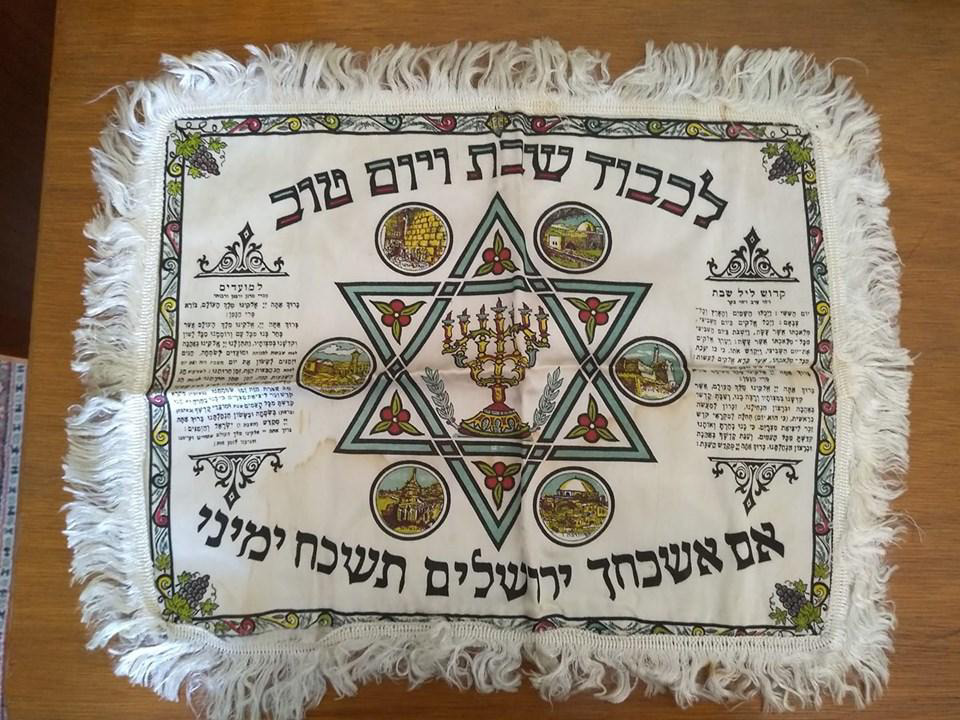
Other important plants are the palm tree, the myrtle, the willow and the citrus which are used in the Sukkah ceremony. A palm branch, three myrtle branches, two willow branches are held together in a bouquet called lulav which is held with the right hand. A citrus called etrog is held with the left hand. They are held together and offered to all six directions while praying to show God’s presence in the world.
Hoshana Rabbah is a special synagogue ritual held the seventh day of Sukkah. Five short willow branches tied together with a palm leaf are beaten on the front seat until the leaves fall on the ground. The branch itself is ritually thrown on the ground when it has lost its leaves. According to Nina, this symbolizes life after death since leaves will grow again on bare branches every spring.
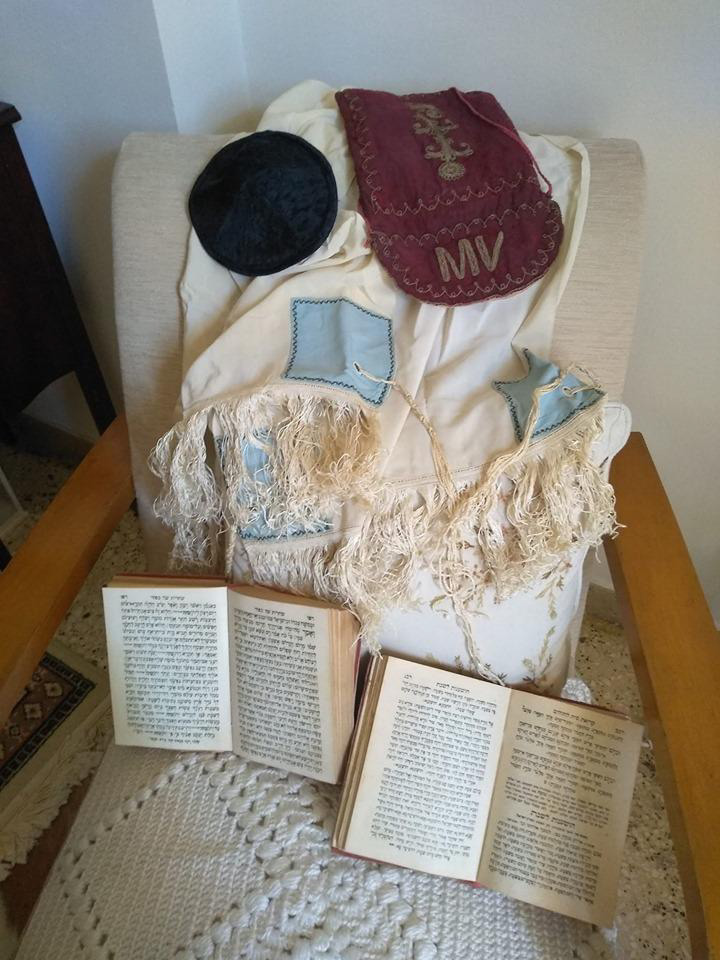
The Orthodox and Catholic religious tradition on the island are quite similar due to the close relationships between the people practicing them and the many weddings between people belonging to each one. The use of plants attributed to the Christian Orthodox Church is the same as for the Catholic Church in Corfu. Despite the difference in calendar elsewhere, the Catholic Church participates in all events of the Orthodox Church and both Churches celebrate Easter together, having arranged papal dispensation for this. What is unique to the Catholic Church is the washing of feet on Holy Thursday, where the essential oil myrrh is added to the water.
In the Orthodox Church, plants are used for decoration, but in many cases they are also central to the liturgical rituals. Placing flowers or basil at the foot of an icon or around an icon in the church is an expression of a person’s faith. It can be as an offering for when someone is in need, but it can simply be out of love and gratitude. It can also be a sign of thankfulness for something that has happened or is yet to happen.
Flower bouquets in vases share their beauty and fragrance with the people present. Fresh flowers are arranged around the icons during the service. On the day that each specific church celebrates the saint to whom it is dedicated, myrtle is the main plant used for decoration.
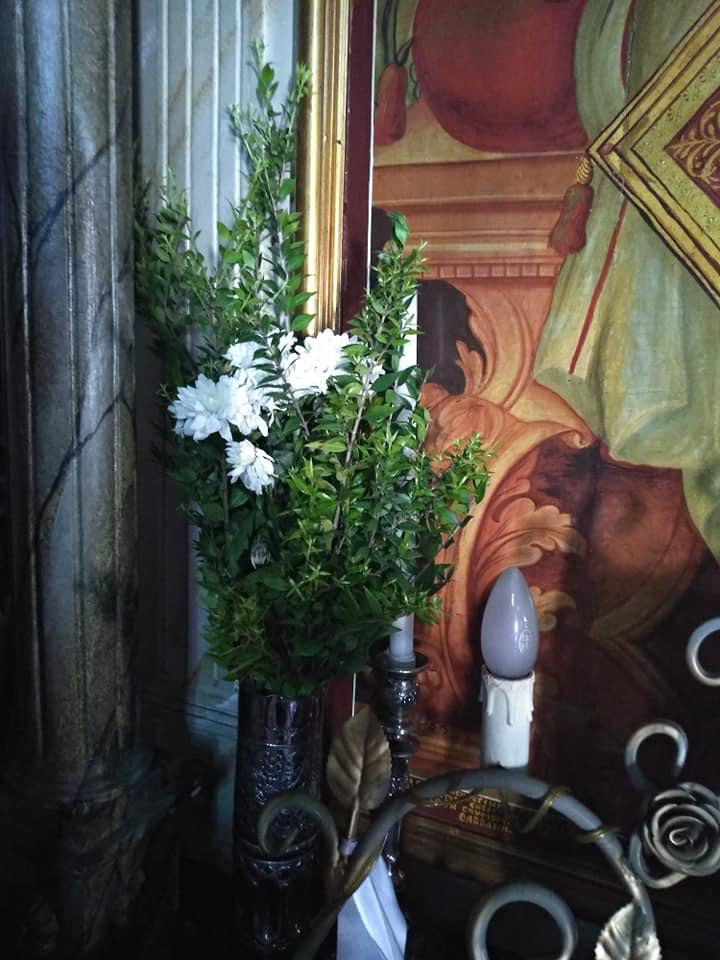
The most important religious celebration on the island of Corfu is Easter. The festivities start on Palm Sunday, the day that the Orthodox Church celebrates the triumphal entrance of Jesus into Jerusalem. Jesus rode on a donkey into Jerusalem and people laid down palm branches in front of him. Palm Sunday is the Sunday before Easter. The blessing and distribution of the palms is an important part of the specific divine liturgy. Palm crosses woven by the people living near the church are placed in a basket in front of the icon of Jesus and prayers are read. The palm crosses are then distributed to the people present. The palm crosses are kept in the Ikonostasi (the place where the icons are kept in the house) and are considered blessed. When someone is seriously ill or when something bad has happened, women burn the palm crosses, smudging the house to cleanse the energy.
The whole neighborhood or the whole village participates in the weaving of palm crosses the day before Palm Sunday. Olive tree springs, rosemary, sage and bay leaves are also woven into the palm leaf cross.
Young fresh spring palm leaves which are still yellow in color are used to make the palm crosses. Fotis Souvlakis in the village of Agios Vassilios showed me the whole process.

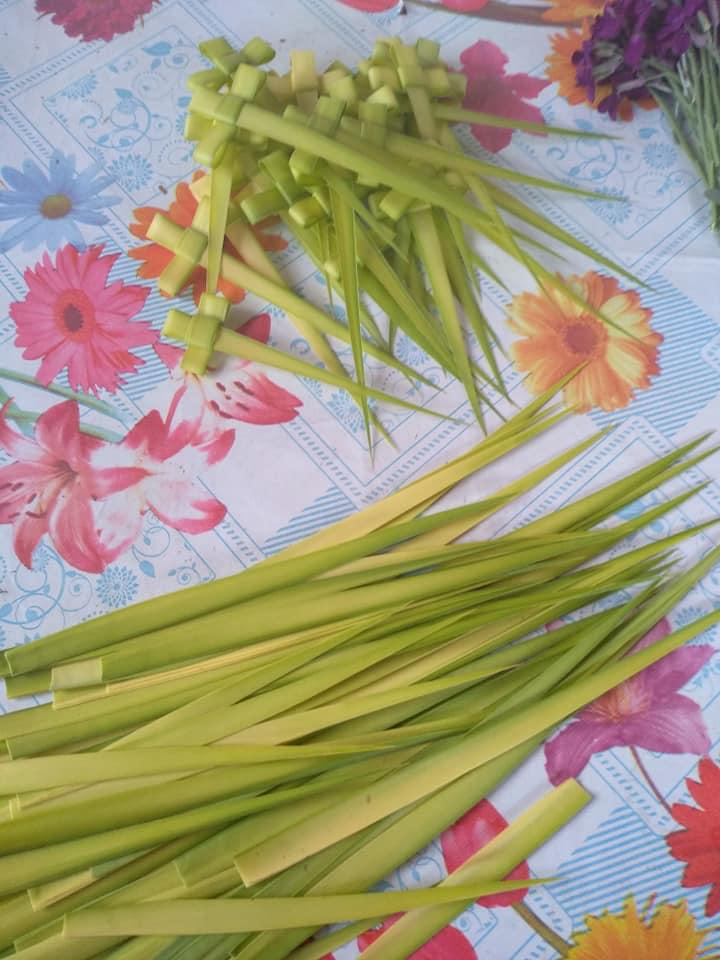
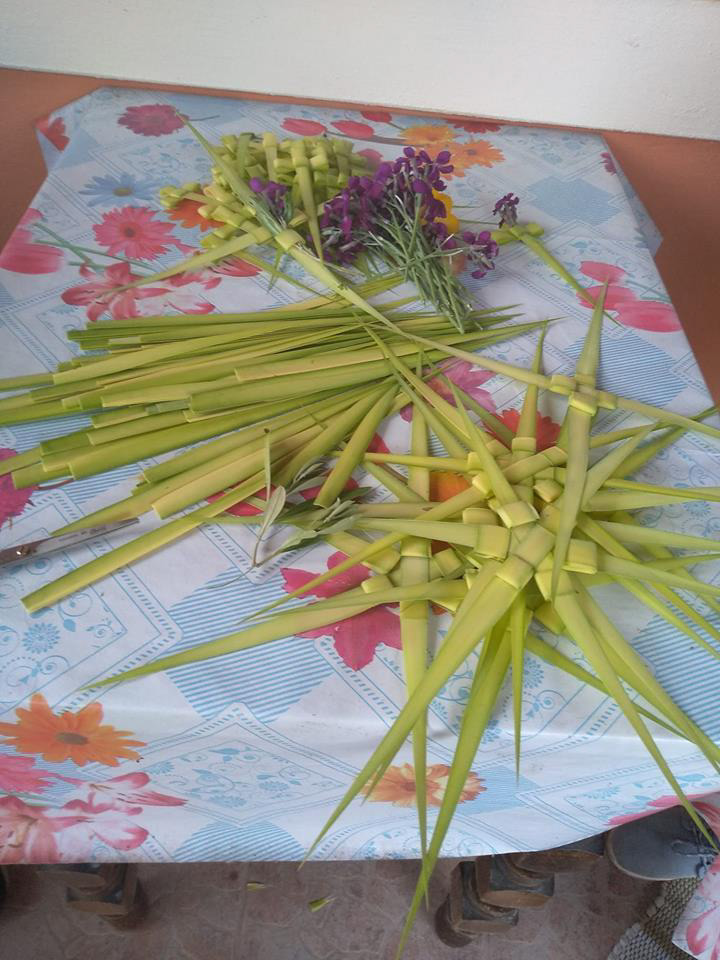
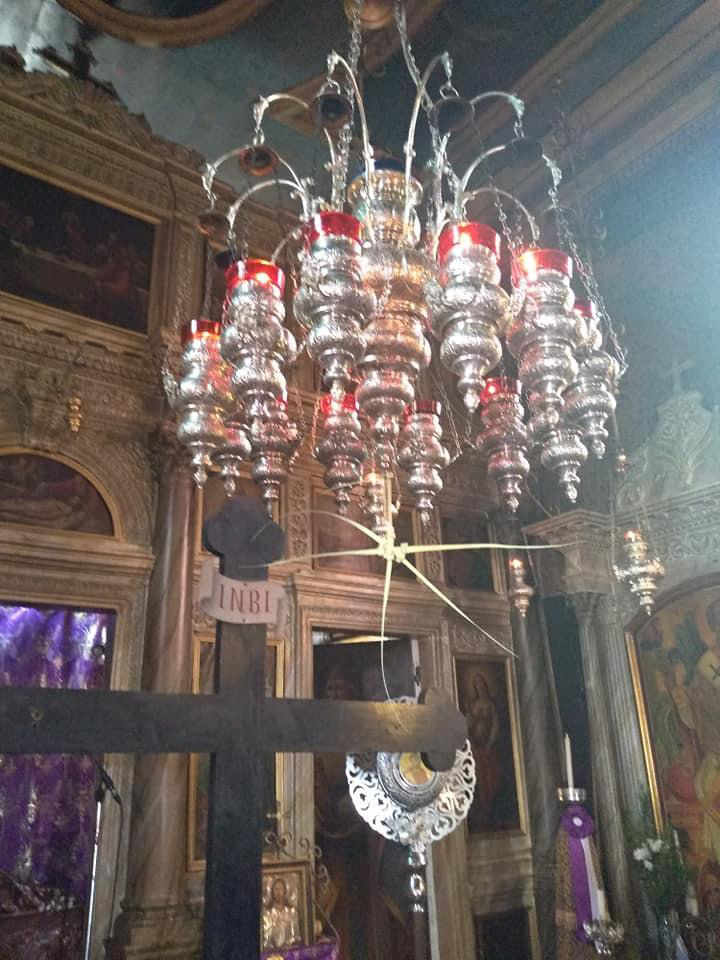
Palm leaf stars hang from the lights and the vigil lamps in the church.
Palm branches symbolize victory and decorate the main gates inside and outside the church on special occasions such as the celebration of the Resurrection of Christ, the Exaltation of the Cross, the Epiphany etc.
In Corfu town, a procession of Agios Spyridon, the Saint that protects the island, follows the Divine Liturgy on Palm Sunday. The procession has been held since 1630 and the all of the 18 marching bands of Corfu participate in it. The musicians of the bands marching with the procession wear palm crosses on their hats.
The Holy Week has always been of great significance to Greeks. Even nowadays, many people are deeply connected to the martyrdom of Jesus, which is recalled during this week. When I was a child, Holy Week was the saddest time of the year. We were not allowed to laugh, sing, listen to music, have fun, eat or live like we normally did. Purple is the color of the deep sorrow that spreads day by day all over the island and, we can note, this too is the color of nature at this time of the year. Spring comes to Corfu in violet and purple tones radiating from the explosive Judas tree blossom and the honesty and wild geranium flowers that cover the fields.
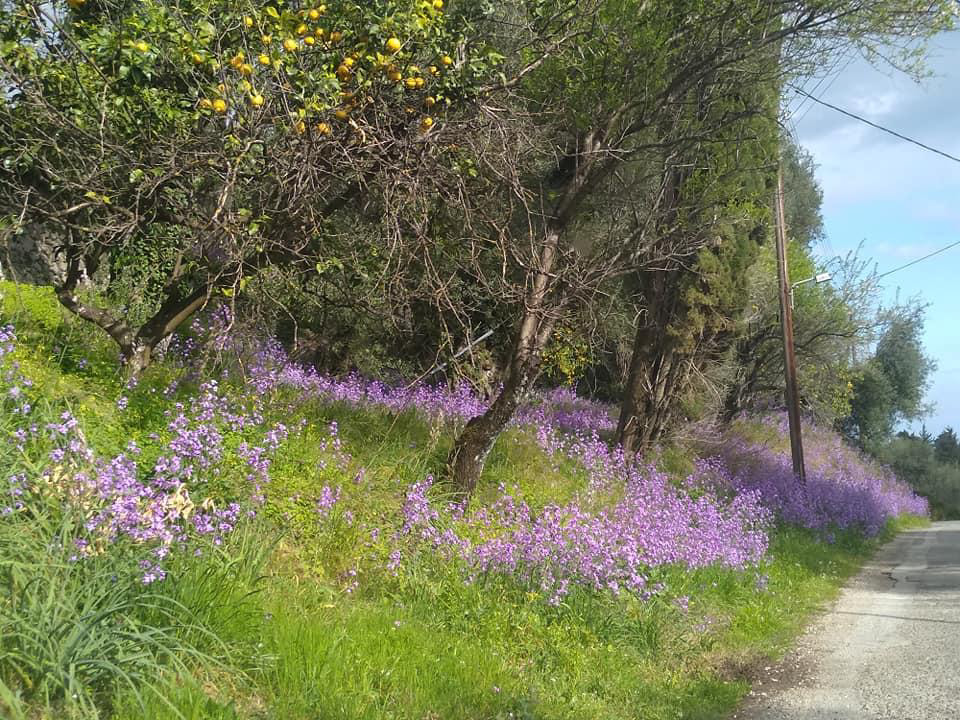
All lights in Corfu town are shrouded in purple, including the lanterns in the arcades of the Liston in the central town square, as well as the cross on top of the Venetian Old Fortress.
Purple symbolizes mourning and devotion. Purple cloths hang from the windows and balconies during the Epitaphios procession.
The Epitaphios procession, in which a wooden bier bearing an image of Christ and richly decorated in flowers is carried from the church, starts from early morning and finishes at almost midnight. In every church, people living in the area bring flowers from their gardens for the Epitaphios. Nowadays, flowers are also bought and in this case, they are mostly carnations. The most commonly used flower was what is known as floetes, Matthiola incana in Corfu and it was once very common in the gardens. People that still have them always reserve them for the church.
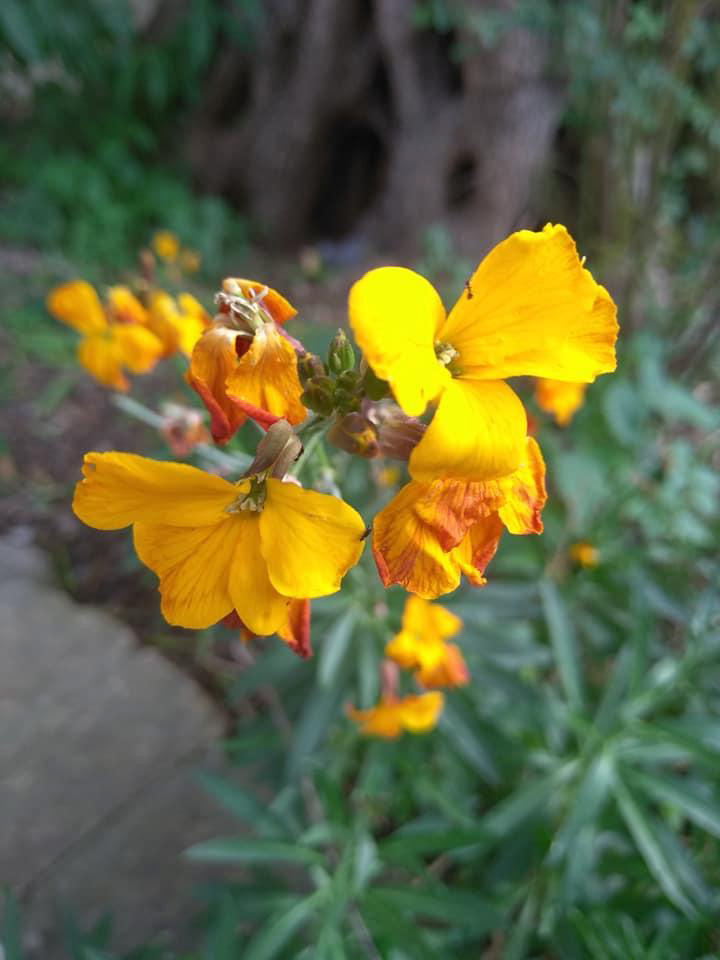
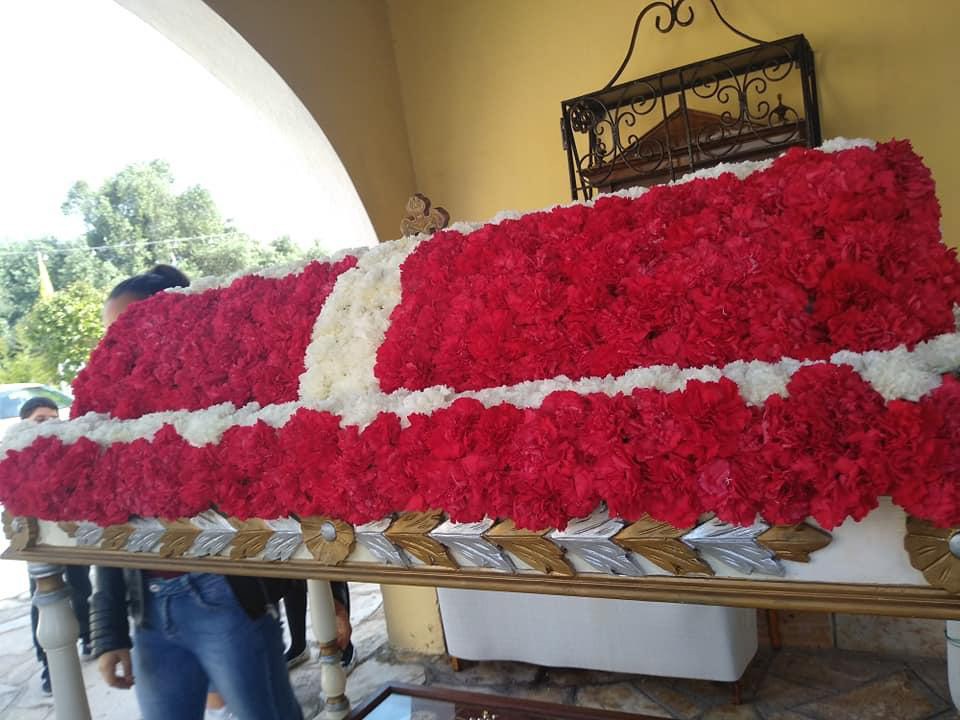
The announcement of the Resurrection of Christ is the most important event in the Christian Orthodox Church and laurel is the plant that is connected with what is considered the triumphant victory of life over death.
In Kefalonia, Easter eggs are always dyed with a seaweed that releases red color when boiled. Unfortunately, I haven’t managed to find out the scientific name so far. The same happens in the villages situated close to the sea in the south of Corfu.
Recipe
Add 3 liters of water and the seaweed to a large pan. Bring to the boil and skim off all foam. Add two tablespoons of vinegar and one tablespoon of salt. Boil for 5 minutes. Remove from the heat and let the dye cool.
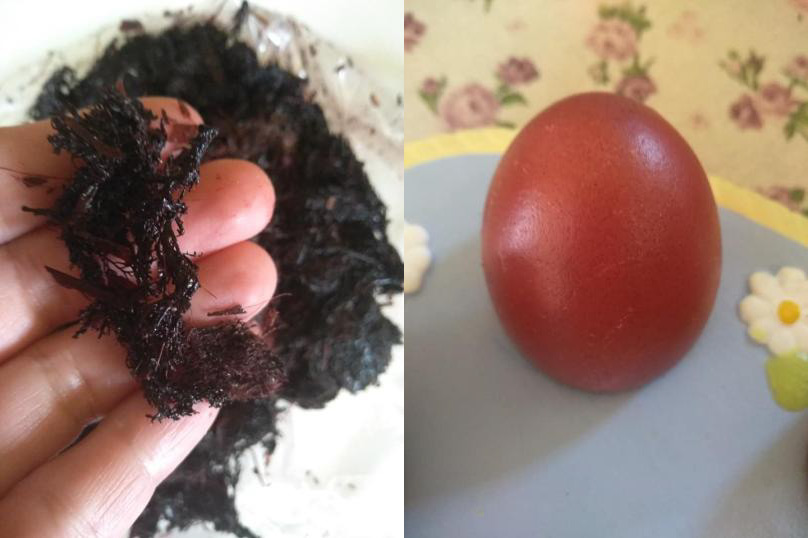
Wash the eggs in soapy water and place them in a single layer in a pan. Strain the dye and pour it over the eggs until completely covered. Boil for twenty minutes. Let the eggs soak in the dye for two to three hours. When pleased with the color, remove eggs with spoon, pat dry with paper towels and let dry. Apply olive oil with a soft cloth to make the color more vivid and intense.
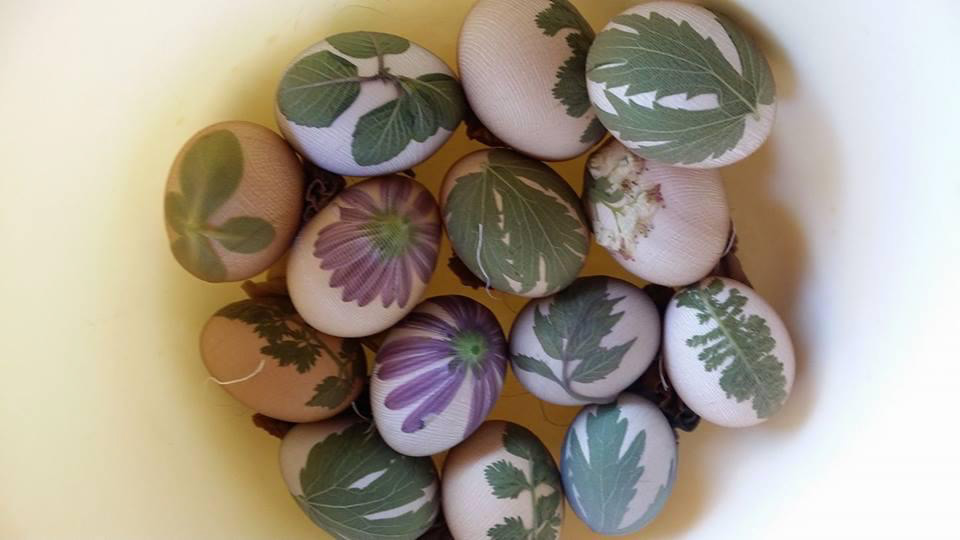
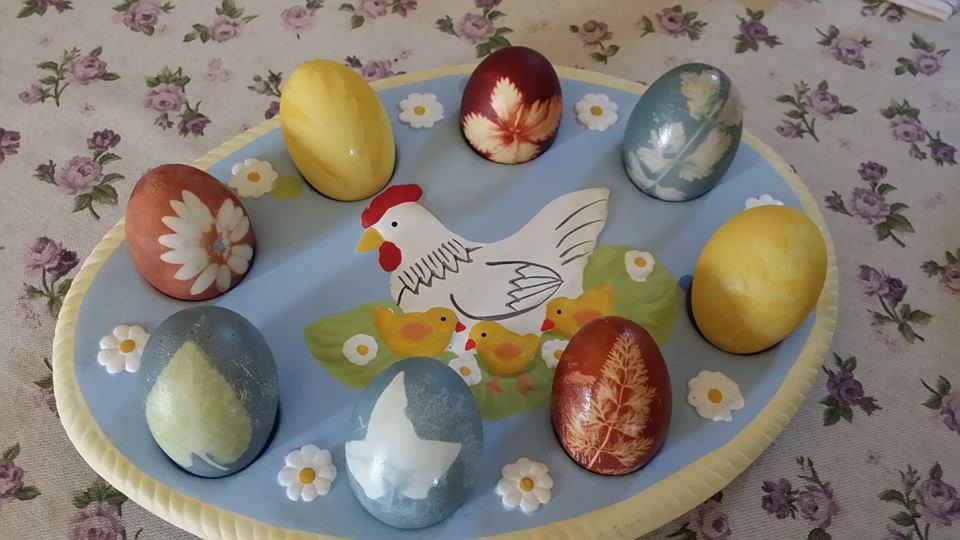
The Exaltation of the Holy Cross is celebrated each year on September 14. The feast commemorates the finding of the Cross of Jesus by Saint Helen, the mother of the Emperor Constantine.
On the day of the feast, the Cross is placed on a tray surrounded by branches of basil and flowers to be taken in procession through the church. The tray is placed on a table, and the priest takes the Cross and offers petitions from each side of the table, the four directions of the compass. This represents the universal nature of the offering of Christ upon the Cross. At the conclusion of the service, the people come and venerate the Cross and receive the basil from the priest. The basil is used and offered, as it was the fragrant flower growing where the Cross was found.
Basil is one of the most sacred plants for the Orthodox Church. It is believed it was found by St Helen growing above where the Cross of Christ was hidden in 325 AD. The plant is called vasilikos in Greek which means “royal” and it refers to the “King of Kings”, Jesus Christ .
It is used extensively in Church services for blessings and purification. Its main purpose is for sprinkling Holy Water and to bless the faithful. When a blessing with water is done, each person attending comes up to the priest, kisses the Cross he holds, his right hand and is then lightly tapped on the head with basil soaked in Holy Water.
People offer basil to the church when it is needed for a service. It can also be left as an offering beneath icons or relics. Basil is also used to decorate the Church in Epiphany (6th Jan), during Holy Week or even put in a glass of water at home and placed in the “icon corner” (a part of the house analogous to the home alter in Western Christianity).
Once basil has been dipped in Holy Water, it cannot simply be thrown away. It should be buried in a corner of the garden when no person or animal walks, or burnt.
Epiphany is celebrated on January 6th each year and a ceremony to bless all waters is held in the church, the sea and the springs that provide water to the community. The church is decorated with cypress branches on that day. Cypress is another sacred plant for the Christian Orthodox Church. The tree is always planted in cemeteries because it is considered a plant that moves energy from the earth to the sky and helps souls to leave the earthly dimension safely.
Frankincense is used as incense in all church ceremonies. In the past, women commonly burned frankincense at home to purify its energy and bless the icon corner. Frankincense smoke symbolizes the prayers that rise to Heaven and it is an offering to God.
Incense is burnt on charcoal in a decorated burner/censer. The priest swings the censer to and fro and the fragrant smoke travel upwards to Heaven – just like the prayers. The priest blesses the sanctuary, icons and relics. When a person is blessed with the fragrance of incense they bow their heads – the fragrance represents God’s grace poured out upon the people.
When visiting the cemetery, people clean the grave, light the vigil lamp, place flowers and burn some incense over the grave, as they say prayers for the person that has passed away.
Myrrh is used in many ceremonies, including the christening of a baby, as well as for the purification of the icons and the equipment used in the church.
However, the most sacred plants for the Orthodox Church and for most people in Greece are the olive tree, the vine and the wheat.
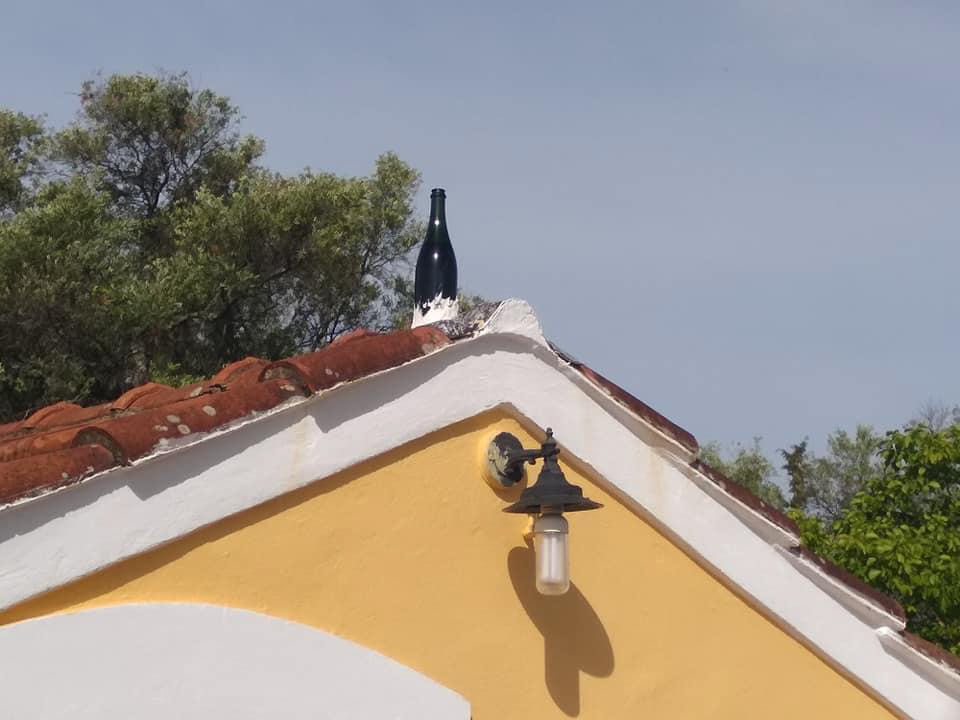

People building a new house in the villages of Corfu used to put a bottle of wine and a bottle of oil on the roof so that they would attract abundance of these precious plant products to their household.
Olive oil is used by the Orthodox Church in three of the seven Holy Sacraments: the Baptism, the Chrismation (a form of Confirmation) and the Holy Unction.
The child or adult who is baptized is anointed with sacred olive oil. The priest blesses the water in the font and adds some olive oil which the godparents have brought. The godparents undress the child. The priest makes the symbol of the cross with olive oil on various parts of the child’s body. After that the godparents apply olive oil all over the child’s body and hand the child to the priest. The priest dips the child in the water into the font three times, a symbol of Christ’s three day death and resurrection. At the end the priest gives the child to the godparents who dress it in white clothing, a symbol of purity.
The Holy Unction is a ceremony performed in order to help someone who is ill. The priest reads prayers and then anoints the forehead and the hands of the sick person with olive oil.
Wine plays a significant role in the Eucharist, one of the seven Holy Sacraments and perhaps the most important ceremony for a member of the Orthodox Church. The rite was instituted by Jesus Christ during the Last Supper, giving his disciples bread and wine. Jesus commanded his followers to “do this in memory of me” while referring to the bread as “my body” and the cup of wine as “the new covenant in my blood”.
Communion, represented by drinking wine from a common cup at wedding ceremonies, testifies to the union of newlyweds into “one flesh” before God. The same happens during the “Eucharist” where all people participating in the ceremony have a teaspoon of wine from the same cup.
The third most important plant is the wheat from which the bread that is also used in the Eucharist is made.
Like most Greeks, I was brought up in a family where olive oil, wine and bread were considered sacred and people worked with devotion to produce them.
